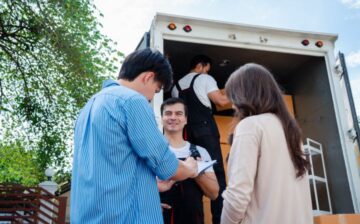
Starting a long-distance relocation is a thrilling journey filled with the anticipation of fresh opportunities. Whether you’re moving due to employment, family obligations, or a desire for a change in surroundings, the idea of a new beginning is exhilarating. Nonetheless, undertaking a move across state boundaries can be a stressful endeavor that demands meticulous preparation and a strong knack for staying organized.
The key to a successful long-distance move is staying organized from start to finish. This blog will provide essential tips and strategies to ensure your long-distance move is as smooth as possible. From planning and packing to utilizing shipping containers for storage, we’ve got you covered.
Start Early and Plan Thoroughly
The first and most crucial step in organizing a long-distance move is to start early and plan meticulously. Begin by creating a moving checklist. Your checklist should include important dates, a budget, and a list of tasks you must complete. Make sure to include the moving date, critical deadlines for packing and hiring services, and a breakdown of costs. Having a clear plan will help you stay on track throughout the process.
Declutter and Downsize
Before you start packing, allocate some time to declutter your residence. Long-distance relocations can be expensive, and the less you bring with you, the greater your potential savings. Approach each room systematically, determining what to retain, sell, give away, or discard. Keep in mind that the objective is to reduce your belongings and streamline the packing procedure.
Use Quality Packing Supplies
Invest in high-quality packing supplies to protect your belongings during the move. Sturdy moving boxes, bubble wrap, packing paper, and packing tape are essential. Consider using color-coded labels for each box to help with the unpacking process. You can find these supplies at your local moving supply store or online.
Organize Room by Room
When packing, tackle one room at a time. This approach will help you stay organized and prevent items from getting mixed up. Make sure to label each box with its contents and the room it belongs to. Keeping similar items together will also help streamline the unpacking process.
Utilize Shipping Containers for Storage
Shipping containers can be a game-changer when staying organized during a long-distance move. You can rent a portable storage when you’re moving, which allows you to pack your belongings at your own pace. These containers are then picked up and transported to your new location. This simplifies the packing process and provides secure storage during your move.
Portable storage containers come in various sizes, so you can choose the one that suits your needs. Pack the container strategically, placing heavier items at the bottom and fragile items on top. You can access your belongings while in storage, which is especially convenient if you need something before you arrive at your new home.
Keep Important Documents Handy
During a long-distance move, it’s crucial to keep important documents organized and easily accessible. This includes your identification, passports, medical records, insurance policies, and financial documents. Consider using a dedicated folder or binder to keep all these documents in one place.
Pack an Essentials Box
Although the majority of your possessions will be placed in storage or loaded onto the moving truck, it’s advisable to prepare a “necessities box.” This box should encompass essential items you’ll require right away upon reaching your new residence, such as personal hygiene products, spare clothing, vital documents, and fundamental kitchen supplies. This box will help you avoid digging through packed boxes to find essential items.
Notify Important Parties
Don’t forget to inform key parties of your upcoming move. This includes notifying your current and future utility companies, the post office for mail forwarding, your healthcare providers, and your children’s schools. This will help ensure a smooth transition to your new location.
Keep a Digital Inventory
Create a digital inventory of your belongings as you pack. Utilize your smartphone or a camera to capture images or record videos of the contents within every box. This practice aids in recollection of the box’s contents and serves as documentation for insurance claims should any damage or loss occur during the move.
Hire Professional Movers
Consider hiring professional movers, especially for long-distance moves. They have the experience and equipment to transport your belongings safely. Make sure to research and select a reputable moving company, get multiple quotes, and read customer reviews. Professional movers can also guide packing, labeling, and loading your items into the truck or shipping container.
Stay in Communication
Throughout the moving process, communication is key. Keep in touch with your moving company, if you’ve hired one, to ensure they’re on schedule and have all the necessary details. You can also use tracking tools for shipping containers, if applicable, to monitor the location of your belongings during transit.
Plan for Pets
If you have pets, plan for their well-being during the move. Make sure they have proper identification and arrange for a safe and comfortable environment for them in the car or plane. Familiarize yourself with pet-friendly accommodations along the way and consider their needs during breaks in the journey.
Update Your Address
Ensure all your important accounts and subscriptions are updated with your new address. This includes banks, credit cards, magazine subscriptions, and online shopping accounts. Don’t forget to update your address with government agencies for tax purposes and voter registration.
Safeguard Valuables
Keep valuable and sentimental items with you during the move rather than in the moving truck or storage container. This includes jewelry, important documents, family heirlooms, and expensive electronics. Pack these items securely in a small bag or box that you can always keep close.
Plan for Unpacking
As you approach your new home, think about the unpacking process. Label boxes with priority numbers to indicate the order in which they should be unpacked. Consider creating a floor plan for furniture placement in your new home. This will help the movers place items in the right rooms and streamline unpacking.
Prepare for the Unforeseen
No matter how organized you are, unforeseen challenges may arise during a long-distance move. It’s essential to have a contingency plan. This might include extra funds for unexpected expenses, a list of hotels along your route, and a method for addressing any issues that may arise during the move.
Settling In
After reaching your new residence, allocate some time to acclimate and become acquainted with your surroundings. Venture out into your fresh neighborhood, locate nearby shops and services, and make the effort to introduce yourself to the neighbors. Becoming familiar with your new environment can facilitate a smooth transition into your new life.
Staying organized during a long-distance move reduces stress and ensures a successful transition. Proper planning and organization can make your long-distance move a manageable and enjoyable experience.
We hope you found this blog post on How to Stay Organized During a Long-Distance Move, useful. Be sure to check out our post on Short Smart Tips for Your Long Distance Move for more great tips!
Have Experience in the Moving Industry? Want an Additional Income Stream? Work With All Around Moving!
Team up with us, moving relocation consultant and we’ll help you make money. Click here to learn more.





